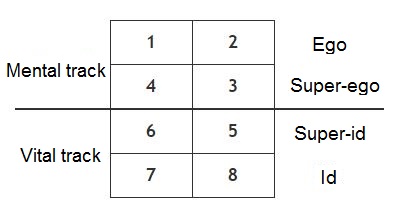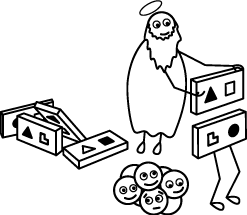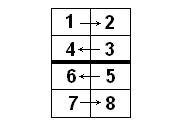Blocks and rings of the A-model
Pairs of functions are grouped into blocks in the following way:
«Ego» — f. 1, 2
«Super-ego» — f. 3, 4
«Super-id» — f. 5, 6
«Id» — f. 7, 8
We can consider each block in the model as a «single organism, which performs a certain type of work for the whole model. Practically, it was noticed that block functions so closely interact with each other that they «sound» as a unit. The ability «to hear» the block sound helps to define the Type of Information Metabolism (TIM).
Rings (or superblocks) «mental track» and «vital track» combine 4 functions each (or 2 blocks each). The mental track ring – f. 1, 2, 3, 4 (ego and super-ego blocks). The vital track ring — f. 5, 6, 7, 8 (super-id and id blocks).


Super-ego and super-id are control blocks, while ego and id blocks are executive.
Running ahead I shall note that control blocks contain low-dimensional functions (3, 4, 5, 6), while executive ones – high-dimensional (1, 2, 7, 8). This fact is not always easy to understand. It seems that control is the destiny of strong and clever.
However, control is not the performance of work but only a signal to action. In this way, cry of a baby makes adults execute all his wishes. In this way, the turn of ignition key starts the car. In this way, the signal of a trumpet rouses the army. We shall consider the process of control in more detail in the chapter «Dimensions of functions».
Mental track and vital track superblocks
The determination of a function belonging to mental track or vital track superblock is as important as the determination of the function dimension or sign. A mistake in defining the «vital/mental quality» results in obtaining «palindromes» (quasi-identical TIM) when the vital track takes the place of the mental track.
Vital track — is the embodiment of Nature’s economy. Everything that have been thought over, can be performed automatically, there is no need to waste attention and energy again and again for thinking over the things that are well known. If you try to race with your vital track, you’ll be disappointed in your ability to be conscious and «quick as a thought» because the automatic reactions are quicker anyway.
Probably, your parents or teachers have told you more than once: «You’d better first think, then do (speak)». I’d gladly do so… but this smart automaton somehow beats me in the speed of reactions each time. It’s nice that it protects our mentality against extra non-productive work. But it is not so good when you understand that some customary reactions do not suit you any more.
Can one call vital quality of information processing non-conscious? I don’t think so. We are conscious of our vital track. But awareness comes after the reaction, even though by fractions of a second. Such automatic reactions are called by some psychologists «preconscious» — something in-between consciousness and subconsciousness.
It is difficult to plunge into thinking over the information of vital track information elements. You get pushed to the mental track as if a cork from a bottle and you begin to think over (process) only such information elements that correspond to mental track functions.
Still, you can recollect your vital track reactions. It looks as if reminiscence of something that happens in a usual way, that’s why the vital track always stays in the past for our consciousness.
The second peculiarity: the contents of vital track functions is the result of individual period of psyche development, the period when we are individuals, when we are the hub of the universe, when everything rotates around us, around our interests, when we are still children and we are not interested in the society with all its demands. Socionists say: the vital track is the superblock of individual life activity. This means that vital track functions work for our individual needs and in the way that is customary and comfortable for us.
The «model start button» (suggestive function) is situated in the vital track. It is beyond your reach. You cannot consciously exert influence on it, which means that you cannot control your suggestion, your suggestibility. You cannot interfere with the process of starting and, consequently, you execute your role of a system element, the purpose whereof being set by some super-system. This small one-dimensional button «starts» the whole mountain of psychic and we shall present the result with all power of high-dimensional blocks Ego and Id. Nothing would be too much for a child! Yes, the super-id block is sometimes called «children’s block».
According to V.D. Yermak, the vital track superblock gets filled up and undergoes training till 14, until well known in psychology «teenagers’ crisis». This means that the attention dominant with children is shifted to the vital superblock, it is being filled up with experience, norms, programs and the istruments of future automatic reactions are being acquired. We often find not completely conscious family programs in the Id block. Something makes a person react in a certain way to certain stimuli, and moreover, react unconsciously. The person himself does not understand and does not find in his memory the reasons for such behavior. But if you absorb in your early childhood, if you watch your parents, if you trace your family line deeper, you’ll be able to reveal for yourself the reasons of some id demonstrations. The id block seems the most remote from consciousness block of our psyche. What do you remember about yourself at the age below 3? Usually, there are very little memories of the early age like that. However, it was at that age that the psyche was filled with experience quantitatively comparable with the information received during all further life. Methods of early development for children are principally based on these specifics (Doman, Masaru Ibuka). Brain cells actively grow up to two years, by three years the bonds between the cells get formed for 70–80 %. The environment that surrounded you in the early childhood was the nutrient medium for filling your vital track.
Thus, we observe the vital track as the superblock with individual interests, assessments, understandings and automatic reactions. Its properties: commonness, repeatability, «rate of fire», suddenness, unexpectedness. And the most important – all this is «my native» and «for me, the beloved one». Usually people avoid exposing their individual features.
The mental track is the superblock of social life activity, it is a person’s superblock. A person goes through the crisis of teenage period when he learns that along with the word «wish» there is the word «must», that there are other people around who also have their own interests and needs and one must correlate own life activity with the life activity of other people (super-ego block).
The mental track is the superblock of well thought over information processing, as well as creative activity and personality development in the society. Social direction of the mental track is reflected in thinking not only about oneself and on one’s own behalf but on behalf of people, society.
All creativity, the creation of something new, all discoveries and inventions of humanity originate from the mental track superblock. It is impossible to create without thinking. However, creative work does not imply only great discoveries. Every day we produce new forms, relations, new feelings, new things, new structures, new ideas, new events.
According to V.D. Yermak, Mental is filled till 28, and it is trained, i.e. works out its programs till 42.
How does «thinking» look? One immediately remembers Rodin’s «The Thinker». How does «thinking» sound? «Thinking» in the process of speech is called reflection, reasoning, consideration, etc. A man deliberately «notes», «notices», «traces», «follows», «observes», «pays attention», «demonstrates», «shows», etc. An observer may notice thinking by facial mimics, eyes movements, pauses, parenthesis, questions asked, internal dialogues (if you are your own observer).
Other papers on the topic:
- Eglit IM TIM identification
- Eglit I.M. Pyatnitsky V.V. Interpretation of human behavior inadequacies in terms of the A-model.
Eglit IM ©
